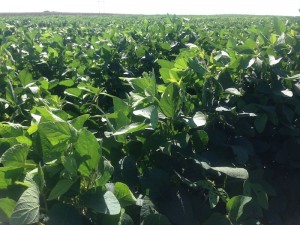A cold-processed sweetener, BigSoy100TM functions as a yield-enhancing product formulated to aid soybean genetics in reaching their full productive potential. BigSoy100TM provides soybean plants with an energy boost, improves a plant’s Brix level and enhances yields. The following four questions further explain the role that Brix readings have in optimizing plant health and performance.
 1. What does the Brix level mean? Brix readings convey the soluble solids level present in a liquid solution. Soluble solids quantified by a Brix reading include sugars, amino acids and minerals, according to a video from The Ohio State University. Because the Brix level includes sugar in its soluble solids assessment, it can suggest a food product’s degree of sweetness. However, a Brix level alone can’t always reliably indicate sweetness given that the value also measures compounds other than sugars.
1. What does the Brix level mean? Brix readings convey the soluble solids level present in a liquid solution. Soluble solids quantified by a Brix reading include sugars, amino acids and minerals, according to a video from The Ohio State University. Because the Brix level includes sugar in its soluble solids assessment, it can suggest a food product’s degree of sweetness. However, a Brix level alone can’t always reliably indicate sweetness given that the value also measures compounds other than sugars.
2. How is it measured? A refractometer can measure the soluble solids content of any food-derived liquid sample. After inserting a liquid sample into the refractometer, the instrument analyzes the extent to which the sample causes light to bend. Samples with high Brix levels will contain higher soluble solids concentrations and, therefore, bend the light more than in samples with lower soluble solid levels, according to a guide from The Ohio State University.
3. How are Brix readings used? Historically, growers have used the Brix measurement to assess horticultural crops. The video from The Ohio State University explains that producers can use Brix data to choose varieties, plan their harvest and allocate irrigation resources. In a written guide, the university further described that the Brix level can supplement visual cues – these include size, shape, color, firmness and weight – traditionally used to determine whether a crop should be harvested and marketed.
4. Why is the Brix level important for a producer? As mentioned earlier, a Brix reading can indicate quality, which affects whether buyers will enjoy a given food product. Thus, products with high Brix readings may have improved acceptability among consumers. Higher levels also present some agronomic advantages for producers. For example, the Brix level can include mineral concentrations in its reading, so plants with higher levels may also contain more minerals to use for growth and development. DTN reports that pests may present a less serious challenge for plants that express Brix levels that meet a given threshold.
The Brix test can also assess grasses and forages. In these cases, a higher Brix reading can suggest that the forage material contains more nutrients, which may enable the forage to better meet the demands necessary for using forage to finish livestock. Higher brix levels may also allow forages to more adeptly withstand disease, pests and drought, according to a story from the Minnesota Farm Guide.
For more information about BigSoy100TM and other BigYieldTM yield-enhancing products, go to www.bigyield.us or call 844-242-4367.
 BigYield High Yield Soybeans, High Yield Corn, and High Yield Wheat
BigYield High Yield Soybeans, High Yield Corn, and High Yield Wheat



